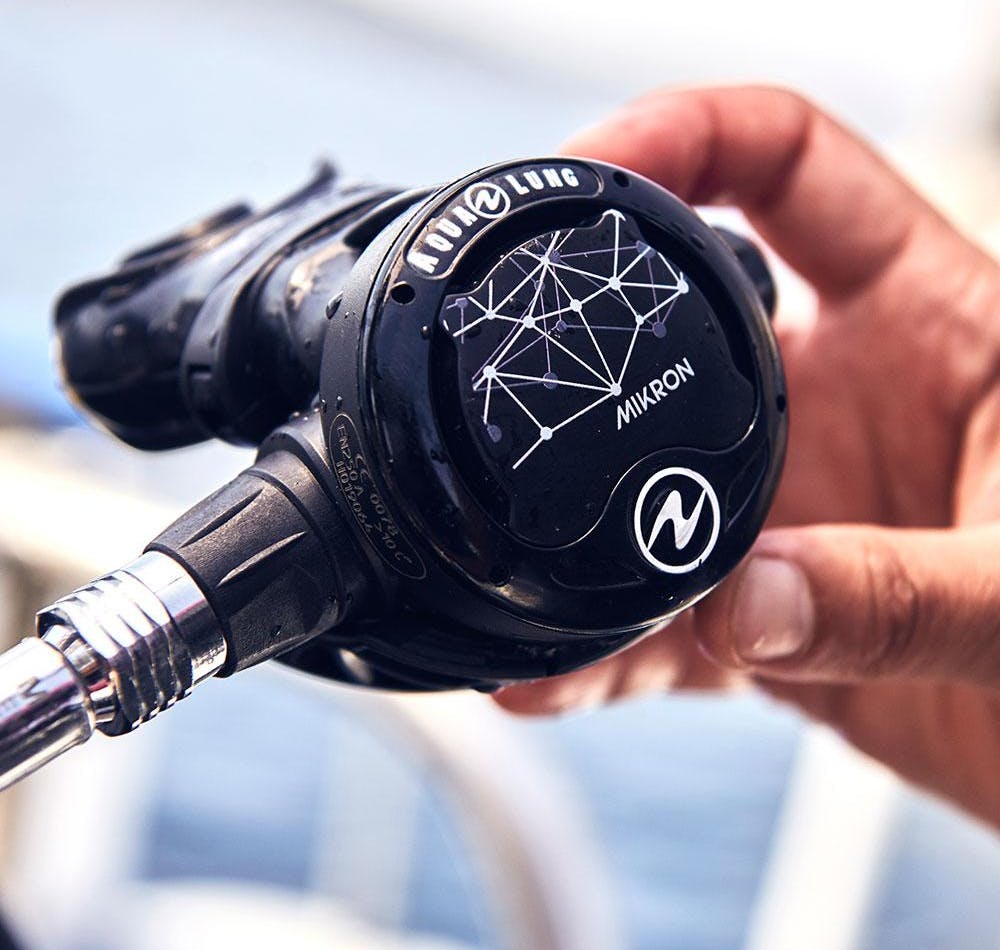Scuba Regulator Buying Guide
What’s the Number One thing divers want out of their scuba regulators? The ability to breathe effortlessly underwater, no matter what depth or conditions you’re diving in. Let's dive into it.
First of all, let’s review some crucial information—what’s the Number One rule in scuba diving? Come on, I know you know it.
That’s right: Never hold your breath, and always keep a smooth, calm breathing rhythm.
With that said, what’s the Number One thing you’ll want out of your dive regulator? The ability to breathe effortlessly underwater, no matter what depth or conditions you’re diving in. There’s a lot going on beneath the surface of the sea, and you’ll be paying attention to quite enough already—the vibrant and exciting sea life, the data on your dive computer, your dive buddies, and more. The last thing you want on your scuba diving experience is difficulty breathing, and aside from your own breath control, your ease of breathing will come from the quality of your regulator. The good news is, as long as you’re buying from a reputable brand and from an established dive shop like Divers Direct, you’ll get a quality regulator that can handle the dive and offer great breathing for your adventure.
But not all regulators are made the same, and their differences could make all the difference in how pleased you are with your new gear. Let’s dive into the details, shall we?
From the Big Picture to the Nitty Gritty
Before we get to the teeny tiny details, we need to have a brief discussion on what exactly a regulator is. Knowing this will help you better understand this essential bit of gear you’ll be buying. So, what is a regulator? Well, oftentimes when we discuss regulators in the scuba world our minds tend to automatically dial in on the mouthpiece part of the equipment, but a regulator is more than just the mouthpiece. There are two main parts of a regulator system to make the whole thing work: the first stage and the second stage. The whole point of this system is to bring breathable air from your tank to your mouth and lungs so that you can successfully breathe underwater.
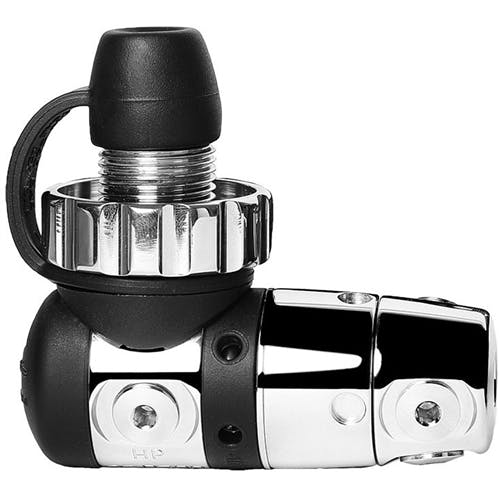
Atomic B2 Din First Stage
First things first, the first stage. The first stage part of the regulator is the piece that connects to your scuba tank. It takes the high-pressure air from the tank and transforms it into a pressure that’s appropriate to be inhaled. There are a few different variables that can alter the first stage’s general mechanics; though, keep in mind that while these mechanics may differ, as a novice recreational diver you may hardly notice any difference between them at all. Considering you’ll likely have this bit of equipment for at least a decade of diving, you’ll really need to envision where your future years of diving may take you. Will you be exploring deep diving? Will you be diving in some rather cold locations? Or will you strictly be a tropical reef diver, swimming about the shallow turquoise waters of the Florida Keys and the Caribbean? These kinds of questions will help you figure out if you’ll need a piston first stage or a diaphragm first stage, or if you should get a yoke connection or DIN connection. What does any of that mean? Well, I’ll tell ya.
To start off on the easier note, let’s discuss the valve options—DIN and yoke. The good news is that there are adapters, so if you get one type of first stage connection and rent a tank with the opposite type of valve, as long as you have an adapter you can still connect the two. The most common type of tank valve is yoke, also known as an ‘a-clamp’ or INT (short for international). Yoke connections tend to be used more for warmer water conditions, though they’re not exactly incompatible with cold water diving. Most divers who are often in cold water rather than warm water simply prefer to use the DIN connection since it screws directly into the valve, thus being a touch more secure when diving in extreme conditions.
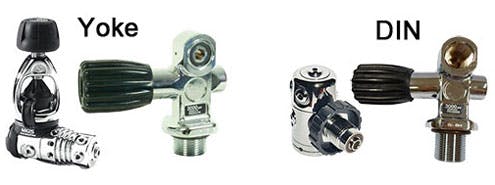
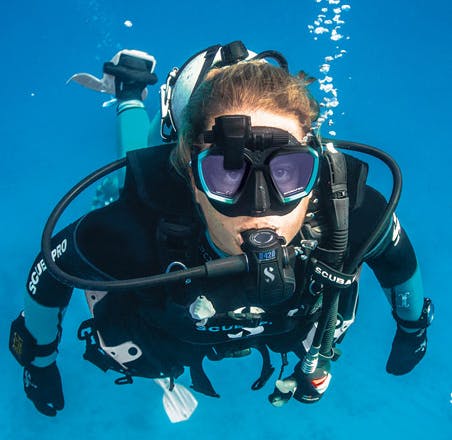
Next up, we’re going to talk about the difference between a piston versus diaphragm construction. A piston first stage is made in a way that exposes the mechanism to the elements. That’s not exactly a bad thing, it’s just the way that it’s made. The only way that it could become a negative is if you find yourself in a location that’s saturated with debris or sand or if you’re diving in extreme temperatures. If you’re diving in cold temperatures with a piston-built first stage, you run the risk of freezing up your gear, and it goes without saying that that’s something you don’t want to happen. Though, not all piston first stages should be avoided when dipping into icy water. Also, if you’re a frequent deep diver (or plan to be in the future), a piston first stage may be more beneficial since it has a higher volume of airflow than a diaphragm first stage. As a plus, it’s also easier to get serviced since it has less parts and pieces than a diaphragm.
Although, many divers tend to prefer a diaphragm first stage, simply for the fact that it’s better protected from the elements and won’t freeze up in cold water conditions. Look, we know you’re probably not thinking about cold water dives right now. You’re likely brand new and just want to dive the local South Florida area and maybe plan to explore Carribean or Mexican reefs or other warm water fun. That’s great if you’re 100% set on warmer dive environments, but the truth is, you never know where your diving may take you. You may be a novice diver right now, exploring 30-foot reefs off the Florida coast for the time being, but within just a few years, you could be doing underwater videography for National Geographic in Antarctica. Okay, that may take a bit more than a few years, but you get the picture. Even if you’re not an award winning videographer by the end of your diving career, odds are that you’ll one day want to explore new places and see new sites and historic shipwrecks and maybe even dive two continents at once at some point (e.g. the Silfra Fissure in Iceland). Anyways, all we’re saying here is, it may be beneficial to consider getting a regulator that’s prepared and ready for anything, and the majority of the time, a diaphragm regulator can handle any dive you take it on—deep, cold, murky, sandy, whatever.
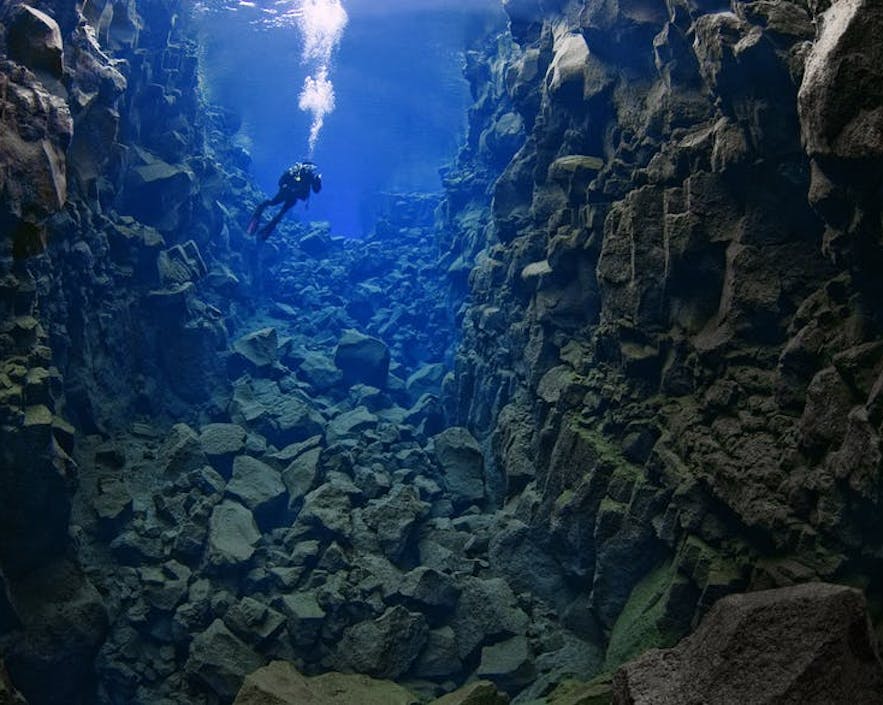
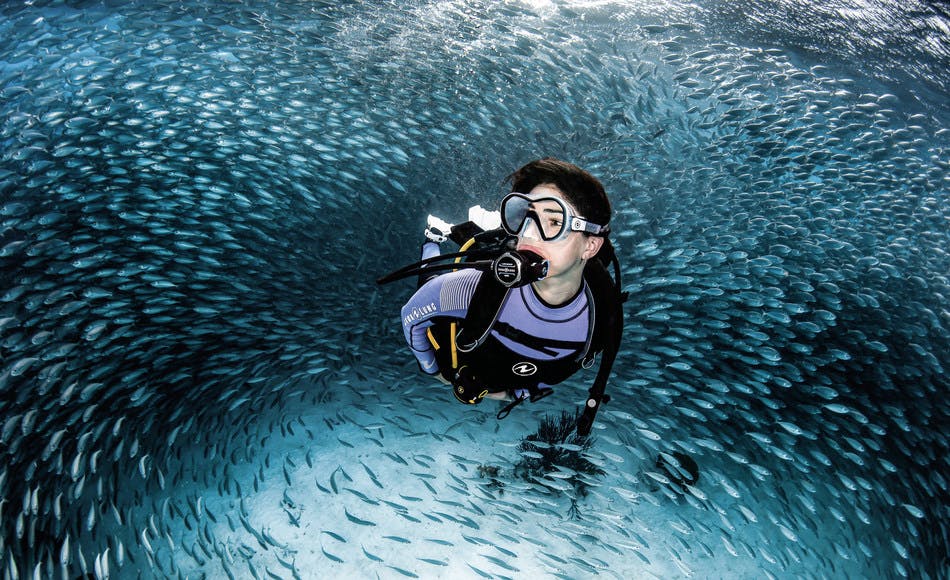
Aqualung Leg3nd
Now let’s consider the differences between a balanced and unbalanced first stage. To be as simple and concise as possible, unbalanced first stages tend to react to the growing pressure of your depth, making them potentially more difficult to breath with the deeper you dive down. Balanced first stages simply balance out that pressure so that you have a more consistent breath no matter what the surrounding environmental pressure is like. Some regulators even boast an overbalanced first stage, like the Aqualung LEG3ND, so that no matter what depth you’re at, your breath will be just as easy at 200-feet as it is on the surface. If you’re only diving a few times a year in tropical water, you won’t even notice a difference between a balanced or unbalanced regulator. But consistent divers, and especially deep divers, prefer a balanced first stage.
The final aspect of consideration for your first stage is the number of ports you’ll need. Each first stage comes with both low pressure (LP) and high pressure (HP) ports that connect your hoses and gear to your tank. Most of the time, your first stage will come with one or two HP ports and about four LP ports. Your LP ports flow air to your second stage regulator, your octopus, your BCD inflation, and, if needed, your drysuit inflation. Your HP ports flow air to your tank pressure gauge, but an additional HP port may be used for the wireless air transmitter for your dive computer if you’re using an air integrated computer system.
Before moving on, let’s review first stage features to look out for.
• DIN (better for extreme temperatures) versus yoke (most commonly used) connection
• Piston (better for depth) versus diaphragm (better protected from debris)
• Balanced (steady breathing at any depth) versus unbalanced (susceptible to pressure at depth)
• And finally, consider how many ports you’ll need
With me so far? Great. Continuing on with our educational adventure, let’s discuss features to consider when choosing a second stage regulator. Since the mechanical differences between certain second stages won’t make as much of a difference in your dive, let’s first talk about what will make a difference in your dive experience and that’s comfort and fit. Here’s the thing, you can’t enter a dive shop and ask to try out all the second stage regulators by putting them in your mouth, gross. So how will you even know what will be a good fit? Good news is that you can buy a different mouthpiece for your regulator if for whatever reason it isn’t a good fit. Most regulators have comfortable mouthpieces already made for them, but if you ever decide you want something else, you can buy a new mouthpiece and easily apply it to the device. But the mouthpiece isn’t the only aspect of comfort in your second stage. The weight will have a significant impact on whether or not it’s comfortable to hold in your mouth. Sometimes a regulator’s description will say that it’s “lightweight” for that same reason, to let you know it’s comfortable and easy to hold on to. Of course, you can also go into your local Divers Direct and literally feel the different weights of each second stage (not in your mouth, don’t do that) to find one that works for you so you’re not dealing with jaw fatigue after every dive.
Now that we’ve talked about how important the comfort of your second stage regulator is, let’s get technical. Very similar to how the first stage can be balanced, the second stage can be balanced too. Now, we’re going to save you tons of time wondering if you should get a balanced set up or not. Ideally, if you can afford it, you’ll want a balanced first stage and a balanced second stage. Balanced regulators significantly alter the ease of breathing so that you’re never having to struggle to get air. Additionally, if you have a balanced second stage, you can then also get an adjustable second stage which lets you control your own air flow. This basically means that if you’re kicking a little harder and swimming against the current, then you can adjust to a freer flow, but if it’s a leisurely adventure and you don’t need all that free flowing air, you can restrict the airflow which will help to preserve the air in your tank, extending your bottom time.
Scuba Regulator FAQ
What does a scuba regulator do?
A scuba regulator is designed to move air from your scuba tank, reducing the pressure so it’s easy to breathe, and deliver it to you so you can breathe while exploring underwater.
What’s the difference between Yoke and DIN?
The Yoke connector uses a clamp type attachment point and rests against the seal on the exterior of the tank valve. A DIN connector is threaded and screws into the tank valve, resting against the seal on the inside of the valve.
What’s the purpose of a scuba octopus?
It’s your backup scuba regulator. In an out of air situation, it can be handed over to your dive buddy so they have air to get to the surface. Additionally, if anything goes wrong with your primary, you can switch over to your scuba octopus.
What is the first stage on a scuba regulator?
Your first stage on your scuba regulator is the mechanism that allows air to flow from your tank into your hose. The first stage regulates the air flow and steps down the pressure so you can breathe easily underwater.
What is the second stage on a scuba regulator?
Your regulator’s second stage further regulates your air flow and allows you to breathe comfortably underwater. This piece contains your mouthpiece and some models contain an adjustment knob so you can control how easy or hard it is to breathe underwater.
